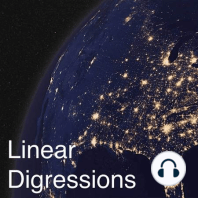10 min listen

Unsupervised Dimensionality Reduction: UMAP vs t-SNE
Unsupervised Dimensionality Reduction: UMAP vs t-SNE
ratings:
Length:
30 minutes
Released:
Jan 13, 2020
Format:
Podcast episode
Description
Dimensionality reduction redux: this episode covers UMAP, an unsupervised algorithm designed to make high-dimensional data easier to visualize, cluster, etc. It’s similar to t-SNE but has some advantages. This episode gives a quick recap of t-SNE, especially the connection it shares with information theory, then gets into how UMAP is different (many say better).
Between the time we recorded and released this episode, an interesting argument made the rounds on the internet that UMAP’s advantages largely stem from good initialization, not from advantages inherent in the algorithm. We don’t cover that argument here obviously, because it wasn’t out there when we were recording, but you can find a link to the paper below.
Relevant links:
https://pair-code.github.io/understanding-umap/
https://www.biorxiv.org/content/10.1101/2019.12.19.877522v1
Between the time we recorded and released this episode, an interesting argument made the rounds on the internet that UMAP’s advantages largely stem from good initialization, not from advantages inherent in the algorithm. We don’t cover that argument here obviously, because it wasn’t out there when we were recording, but you can find a link to the paper below.
Relevant links:
https://pair-code.github.io/understanding-umap/
https://www.biorxiv.org/content/10.1101/2019.12.19.877522v1
Released:
Jan 13, 2020
Format:
Podcast episode
Titles in the series (100)
Facial Recognition with Eigenfaces: A true classic topic in ML: Facial recognition is… by Linear Digressions